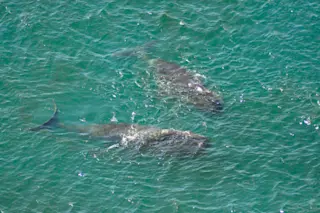In September 2009, a team of biologists flew over the remote Alaskan beach of Icy Cape on a reconnaissance mission. Thousands of Pacific walruses had reportedly broken from their normal habits and shambled onto the shore there, and the scientists were keen to observe their behavior. But they didn't find an unruly mosh pit of jostling animals—the walruses had moved on, leaving behind only a scattering of small carcasses on an empty beach.
"We found over 100 dead baby walruses," says Tony Fischbach, a biologist with the U.S. Geological Survey's walrus research program. The dead youngsters didn't show any signs of disease, says Fischbach: "They were all fat little sausages."
In three of the last four summers, thousands of walruses have mysteriously come ashore in Alaska. This unprecedented behavior occurred when ice in Chukchi Sea drastically retreated, leaving the marine mammals without their usual summertime habitat. Alaskan scientists aren't the ...














